
Tabitha Bagnold
WAINMAN - BAGNOLD – AKERS:
THE HALIFAX POST OFFICE FAMILY
Tabitha Bagnold may have been one of the best-known businesswoman in Halifax in her time, being the Postmistress for the town two centuries ago, a job she still held at the introduction of Uniform Penny Post in May 1840.
Tabitha Dewhirst was baptised at Halifax Parish Church on 26th November 1769, the daughter of Joseph Dewhirst, an ostler. On 8th March 1788, she was married by Licence to William Bagnold, Postmaster, at the Parish Church, by curate, Rev Edward Nelson; William was twenty-two years her senior, and they were both residents of the township. It would seem the marriage was somewhat hurried, as their eldest child was baptised only three months later…
Tabitha
is just one link in a family story connected with “The Posts” of
Halifax for over several generations. And this link was mainly
female. Let us look at her family background, and the early history
of the Halifax Post Office.
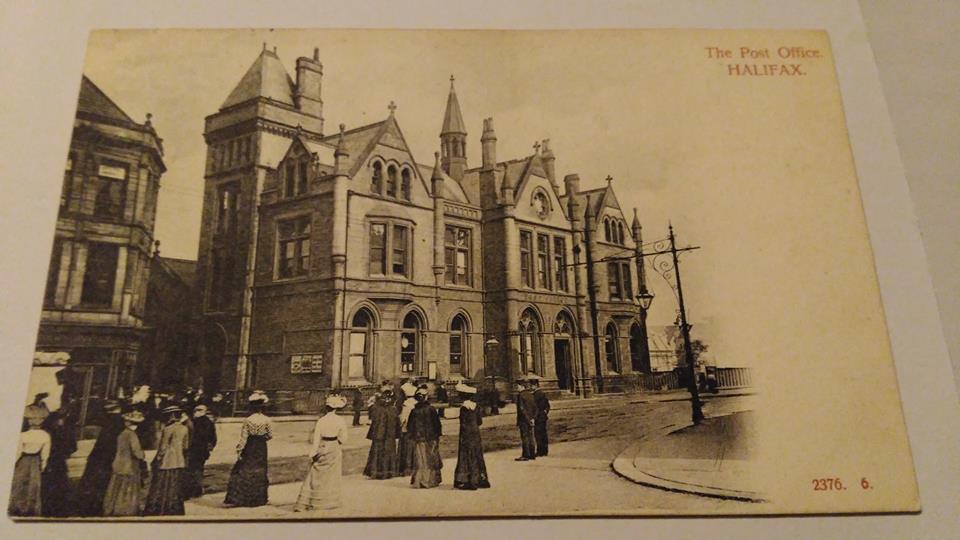
In the late 18th Century, the mail from London for Halifax came up the Great North Road by horse and rider to Ferrybridge, a town which has an importance in Yorkshire postal history far exceeding to its size. All the mail for Wakefield, Halifax, Bradford and Leeds passed through an office there, and was there sorted into separate bags. The “farm” of this office was run for most of the 18th century by a family surnamed Wainright. One of the last partners of Jeremiah Wainright, whose office ceased in 1769, was a certain Richard Wainman of Bradford. This surname was to become significant in Halifax.
When, on 10th October 1769, the Postmaster General took over the management of the Post Office at Ferrybridge, Mrs Mary Wainman was appointed deputy (i.e. Postmistress) of Halifax. She was the sister of the Richard Wainman of Bradford, just mentioned; and the family to which they belonged were landowners at Carr Head near Cowling.
An early record of the Halifax Post Office came from an account book of the year 1770 (whereabouts currently unknown), and relates to “Mary Wainman, deputy at Halifax; salary £60 3s. 4d.” Mary Wainman, who was unmarried (the term “Mrs” was then not applied solely to married women), died on 28th December 1778, aged 70, and was buried in the Parish Church on New Year’s Eve. It is significant she was buried in the church, not in the churchyard; indicating “social standing.” It appears she was directly succeeded by her nephew, William Bagnold; probably he had earlier been her deputy, managing the office. He was certainly working at the Halifax Post Office in February 1777.
However, it can be proved that the Bagnolds family had connections with Halifax earlier than 1777. The earliest reference to the surname in the Halifax Parish Registers appears to be the entry of the marriage of Hannah Bagnold to Rev Henry Bates, son of the Parish Clerk, on 10th January 1774. Hannah was the elder sister of William; they were both children of John Bagnold of Bradford. William had been baptised at Bradford on 22nd July 1747, and, as related above, married Tabitha Dewhirst in 1788. In 1784, in receipt of a legacy from a will, William is described as a “gentleman”. He was clearly a man of some standing, as he contributed two guineas to the fund set up for replacing the bells at the Parish Church in 1787; and in 1809 he subscribed 1 guinea to King George III’s Jubilee Fund. In 1798, William owned property in Stone Dam field, on which he paid Land Tax.
So
- where was the first Post Office in Halifax located? It was in
Winding Road - then known as Windhill Lane - where it becomes Smithy
Stake, today the usefully renamed ‘The Old Post Office’, formerly
‘The Bowling Green Inn’. The only postman in those days for the
township of Halifax was a man always referred to as “Joe Post”; a
little thick-set man who wore a blue serge apron when delivering
letters. He lived at the corner house at the top of Well Lane.
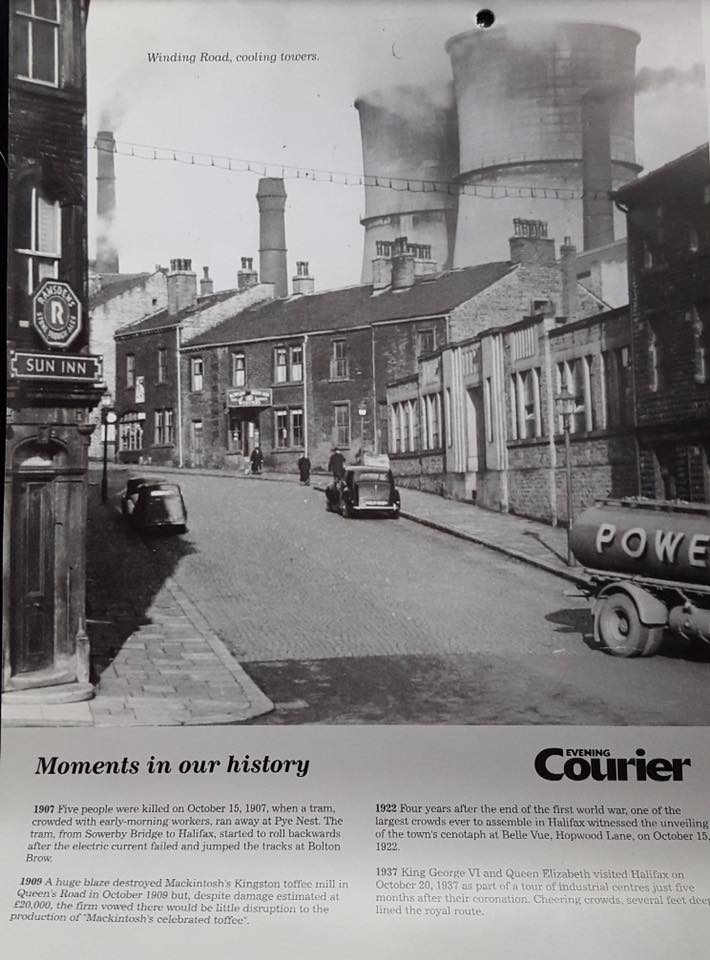
In 1792 the first Mail Coaches came into use. Before this, William Bagnold was paid £112 per year “for conveying the mail between Halifax and Rochdale, 16 miles at £7.” This was a very arduous stage; the haul on horseback over Blackstone Edge in winter must have been challenging indeed. In 1806 the mail coach route to Leeds from Halifax went via Haley Hill, Boothtown, Catherine Slack, Queenshead, Clayton Heights, down the old Halifax road through Great Horton into Bradford; on Tyrrel Street, up Ivegate, Kirkgate, Church Street, Barkerend, over Calverley Moor, Stanningley, Kirkstall Bridge, to Leeds - 18 miles. Before leaving Halifax, the Mail Coach first went to the Talbot Inn, in Woolshops (not far from the north gate of the Piece Hall), then down Gaol Lane, where once, turning too fast around the left-hand corner, it overturned on one occasion! The reason the Mail went that way was to call at the Post Office.
I have discovered one anecdote of William, from an article published in the Courier in March 1872, written in retrospect by “Josephus” (Joseph Sugden):-
‘The Postmaster of the period . . . was in the habit of dropping the night mail bags from his bedroom window, after ascertaining by a private signal that it was the guard who rang the bell. One day it happened that he had been taking part in the christening of his eldest child. Now whether it was the natural excitement of such a momentous occasion, or the potency of the liquids used in ‘washing the head’ of the juvenile, I do not pretend to determine; but it so happened that when the guard rang the bell, Mr. B. leaped out of bed, threw up the window, and without any signal threw down to the guard his own leather breeches. The guard, a shrewd man, at once guessed the situation, stood a few minutes, then again rang the bell, exchanged the usual signal and the bags, then walked away with the breeches. The reader is asked to imagine the consternation of the Postmaster at the mysterious disappearance of his nether integuments, how there was money in the pockets, and the keys, how locks had to be broken open . . . how a report was gradually coming to the fore that Smithy Stake was haunted . . . when, in about three weeks afterwards, the postmaster, on opening the Leeds mail bag, found the missing ‘'breeks’ addressed to Mr. B., postmaster of Halifax, with the compliments of the postmaster of Leeds.’
This account, if can indeed be dated to the baptism of Bagnold’s eldest child, must have taken place in June 1788.
On 7th June 1810, the ‘Halifax Journal’ reported “Mr. William Bagnold, postmaster of this town, resigned his office, and his eldest daughter, Miss Harriet, was appointed in his place.” Probably William was in poor health at that time, for the retired gentleman died on the following 17th October, at the age of 63, being buried in his aunt’s grave in the Parish Church.
Harriet
Bagnold had been baptised at Halifax Parish Church on 19th
June 1788, and that she died on 1st
October 1812, aged only 24 years. She was of the same generation as
Anne Lister, and knew her socially; her name appears occasionally in
Anne’s early diaries. Having succeeded to the office at the age of
22, it appears Harriet had already given up the post to her mother by
March 1812, because on the 9th
of that month, John Edwards of Northowram Hall recorded in his Cash
Book that he paid “Mrs Bagnold 4s. 10d for a letter to Lisbon” on
that day. So it seems that Tabitha, William’s widow had taken over
as Postmistress some while before their daughter Harriet’s death.
In those days it was Post Office policy that married women were not
appointed as postmasters; so it seemed likely that Harriet was put in
as a stop-gap until the death of her father, when her mother might
succeed him. After October 1810, Mrs Bagnold had no bar on her
holding office, as she was a widow for the rest of her long life.
However, when I discovered that William and Tabitha’s youngest
child John was not baptised until 17th
January 1811, and that his birth was posthumous; I realised that
Tabitha would have been in no fit state to take over as Postmistress,
having been pregnant when her husband resigned, and then later giving
birth in her early widowhood. It would seem that she took over from
Harriet as soon as she could manage to cope with the responsibility.
Harriet herself died in 1812, aged 24.
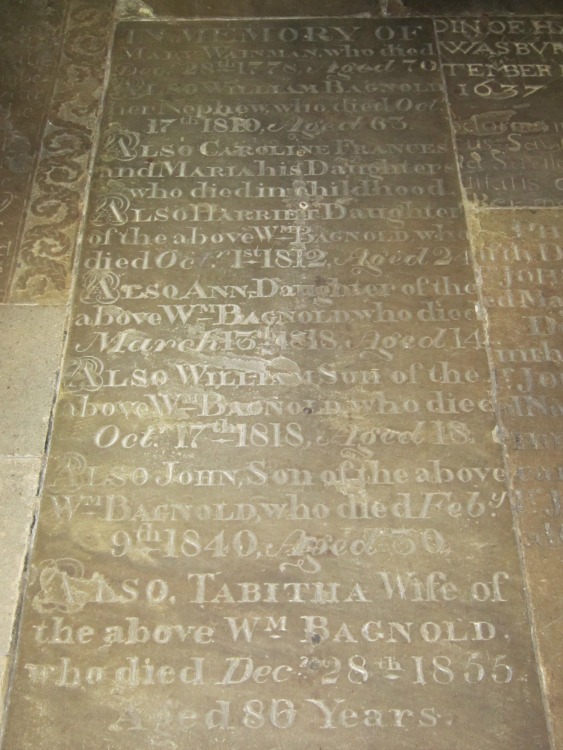
Tabitha was tough, and became known as a formidable lady, according to the only account of her personality I have discovered (in an issue of the “Courier” dated 1872). This describes the Pot Office when in Cheapside circa 1832 “There in a room 18 feet square, was the scene of operations; the manipulators, a boy of 14...… a young gentleman of some 30 years; with the occasional presence of an old lady of some 60 to 65 summers - say winters - and that may account for her occasional irregular temper - whose peculiar accomplishment seemed to be the act of blowing up on the least pressure on the safety valve.” However, the public were not admitted to collect letters -“Instead of the line of wide counters … of the present post office [1872], when the office was in Cheapside … there was a board fitted into a single square in the window facing the street, and in the centre of this a little door, 6 inches by 4, from which orifice the letters were delivered to callers, the paid letters received, and enquiries made and answered. This little door was protected inside by a box fitting to the window, with a hole at the top, so that parties outside had to look up at a face; sometimes if the weather was cold and a breeze on the wing, only a nose or a mouth at the opening from the inside.”
Uniform Penny Post - and adhesive stamps - did not come into being until May 1840, and until that time, it was normal for the amount of the postage to be written in large figures across the address. In those earlier days postal regulations were very strict. A “letter” was interpreted to mean a single sheet of paper, generally half a sheet of a size them called “post”, doubled in two. There were then no envelopes, and it would have been quite an art to fold the letter, only three pages of which were written on, the fourth - when folded and sealed with wax - receiving the address. If a second piece of paper was used - however small - this constituted a double letter, and rendered the receiver liable to pay double or treble the usual rate.
On 11th September 1817, Anne Lister of Shibden Hall wrote to Miss Marsh of York, enclosing a one-pound Bank of England note, eight shillings, and two sixpences, neatly sewed up in paper; and on getting to the Post Office, she found the charge was 4s. 8d postage, after the rate of 2s. 8d per ounce. (The rate to London per ounce was 3s. 8d.) In her diary for 26th April 1820, Anne Lister of Shibden Hall wrote: “Letter from Ann Belcombe (York), charged treble, 1s. 9d., on account probably of Ann Belcombe’s having pasted its own size of lawn paper all along the back, because one of the children happened to tear it….”
In May 1819, Miss Lister had written regarding a journey by mail coach: “Fine morning, my aunt and I set off to walk to the ‘White Lion’ at 6.25. The Mail drove over the bridge when we were at the top of New Bank, my aunt in a sad fright that we should be too late. After all, had to wait about half an hour. Walked forward, and were taken up opposite Westfield [King Cross Lane] at 7.20. I had an inside place, the three outside being engaged, but sat with the coachman through the complaisance of Mr. Huntriss.” This was the start of a journey to London via Rochdale and Manchester. It seems the business-like Anne Lister had forgotten the Mail stayed for breakfast at Halifax. It had been re-timed by 1822, when it left the ‘White Lion’ Hotel at 6.30 a.m.
By 1819, the Post Office had removed to a building opposite the ‘White Lion’ in Silver Street, but by 1822 it had removed to 6 Westgate. There, Tabitha was listed as Post Mistress, the chief clerk was Charles Haywood, and one man, John Milner of 36 Fox Ginnel, Silver Street, was sufficient to deliver the Halifax letters. In 1821 the population of Halifax was only 14,000, and the amount of postal business cannot have been very great.
In or before the year 1829, the Post Office removed to 10 Cheapside. This new location was on the south side of that thoroughfare, near where the Royal Bank of Scotland currently stands. Commercial Street did not then exist.
A Directory of 1830 announced regarding Halifax that there was a “Post Office at 10 Cheapside, Mrs Tabitha Bagnold, postmistress. The office opens for the general delivery of letters at ½ past 7 in the morning from 5th April to 5th October, and at 8 in the morning during the other 6 months.”
In
Pigot’s Directory, 1829, the following information is given for
Halifax Posts:
Letters to London are despatched at a quarter before six in the morning, and arrive at half-past eight in the evening.
Letters to Bradford, Leeds, Tadcaster and York are despatched at one in the morning and a quarter before one at noon, and arrive at two in the morning and a quarter past twelve at noon.
Letters to Bolton, Bury, Liverpool and Manchester are despatched at two in the morning, and arrive at one in the morning.
Letters to Boroughbridge and Wetherby are despatched at a quarter before one at noon, and arrive at a quarter past twelve at noon.
Letters to Huddersfield are despatched at six in the morning and one at noon, and arrive at twelve at noon and eight at night.
Letters
to Rochdale are despatched at two in the morning and a quarter past
twelve at noon, and arrive at one in the morning and a quarter before
one at noon.
And it was quite normal to collect one’s mail from the Post Office. Pity the staff there receiving mail at 2 a.m!
Halifax was very late in getting a direct Mail Coach to London, this not being achieved until 6th June 1836. The coach left Halifax at 10.30 a.m., getting to London at 7 a.m the next morning. It left from the old ‘White Swan’ Hotel, then situated in Crown Street. On Wednesday 2nd May 1838 the number of chargeable letters carried was 1,201, weighing 64 lb. But with the coming of the Railways, the Halifax coach was to prove uneconomical, and it ceased running in April 1839.
Uniform Penny Post, on letters under half-an-ounce in weight, was introduced on 6th May 1840. The Halifax ‘Guardian’ of 9th May indicated that the new-fangled postage-stamps were not particularly popular: “… the adhesive sticking-plasters are altogether beneath criticism… it is utterly impossible that any decent person should stick these dabs into his mouth for the purpose of softening the stinking diachylon with which they are bedaubed…”
In June 1840, soon after the introduction of the Penny Post, Halifax was in a turmoil over the loss of certain letters containing money. The town then had two delivery postmen, and at the home of one of these - George Wadsworth, son of the landlord of the Temperance Hotel, Bull Green - nearly 150 letters were found undelivered. The miscreant was duly dealt with according to law, being awarded six weeks in the County Gaol. There was apparently some wire-pulling as to the appointment of his successor; certain ‘prominent persons’ sought to have the offender’s brother appointed to replace him. This aroused the Halifax ‘Guardian’ to great indignance; and fortunately the matter was not allowed to rest. Mrs Bagnold had wisely refused to entrust letters to the newly-appointed postman. A plain statement of the case was sent to the authorities, and the man’s appointment was cancelled.
If I was to pop into the Post Office today, and ask for my letters which had been posted in London this morning, because I wished to reply before I closed my place of business for the night, I should run the risk of being though quite insane, or, at least, totally unreasonable. But, 166 years ago, I could have made this request without appearing in any way odd. In 1852, business interests in Halifax complained that the 7 p.m. arrival of the London mail posted that day at 9.30 a.m., was much too late, and hindered competition with rival firms in towns which were much better served. The locals protested to such effect that improved postal services announced in the Halifax ‘Guardian’ in May of that year included rail arrangements for letters from the 9.30 London dispatch to be in Halifax by 4.45 p.m. and to be available for callers at five o’clock. And this was before Halifax was served by a main line railway, so it was not regarded as more than a deserved facility that enabled business mail to be dealt with as it should be! However, we must not forget that the quantity of mail handled in those days was very insignificant compared with the vast amount posted today.
Tabitha Bagnold retired as Postmistress in November 1841; she continued to live on Post Office premises she was succeeded in post by her widowed daughter, Mrs. Charlotte Akers, then aged 43. Charlotte had worked alongside her mother, having already been a “sworn clerk” of the Post Office by 1840, and her son also was by then also a clerk there. The ‘Bradford Observer’ reported discontent in the town that the post had not been offered to “a gentleman of active and businesslike habits”; - was this simply misogyny, I wonder?
By 1849 the Post Office premises in Cheapside were considered very inadequate; the amount of mail had grown enormously. On 29th July that year, the Halifax ‘Guardian’ reports “To us it is a marvel how the postmistress is able, with such miserable accommodation as is afforded her, to conduct such a vast amount of business so efficiently. We trust that a public meeting will be held at an early date, and that spirited subscription will be opened for the purpose of erecting, or providing, more suitable premises.” The new Town Council had already formed a Post Office Committee, and by June 1850 the Halifax ‘Guardian’ was reporting new premises had “been taken at number 6 George Street…. In addition to providing increased accommodation for the clerks, a large waiting-room 8 yards by 13 yards will be provided for the public and the convenience of those who rent letter boxes.” However it was to take a while before the move could be undertaken, as considerable preparations and conversion of property had to be made; and these had to be financed by public subscription.
At the time of the 1851 Census, early in April that year, Tabitha is still listed as the Head of household at 10 Cheapside, and her daughter Charlotte Akers, widow, is listed as Post Mistress; but those Post Office premises there were finally vacated a few days later, on 14th April and transferred to 6 George Street. This property was in the rear of Somerset House, and probably around that now occupied by “The Beefeater Grill”. The ‘Guardian’ reported:
“We believe Halifax can now boast one of the most commodious and convenient post offices in Yorkshire, and one which will be commensurate of the increasing business of the neighbour-hood for many years to come. The situation is the most convenient that could have been selected, and the public will now have the advantage of protection from the weather while they wait for their letters. In addition the public will enjoy the benefit of a well-regulated
illuminated clock which has been placed in the doorway of the post office, and which we hope will become the standard for other clocks in the town.”
However, a few years later it is recorded by the Halifax ‘Courier’ that transacting Post Office business at 6 George Street involved standing in a cold, draughty passage, and doing business through small doors only about the size of a pigeon-hole. There was still no counter over which to carry out transactions.
In
1853 Esau Greenwood was the clerk, but Charlotte’s son William
Bagnold Akers (born 1824) was listed as “officer of the Post
Office”. At some stage thereafter the Akers family and Mrs Bagnold
moved to Barum House, Barum Top, where Tabitha died on 28th
December 1855, at the grand age of 86 years. It is significant that
the vicar of Halifax himself, Archdeacon Charles Musgrave, performed
the funeral service, as would only preside at the funerals of persons
whom he considered ‘important’; the Church Registers prove he was
rarely available for funerals. Tabitha was buried early in January
in the family grave in the Holdsworth Chapel at Halifax Parish
Church, where there is an inscription to her memory on the same stone
as that of Mary Wainman and other members of her family. Tabitha
must then have been one of the best-known woman in Halifax, yet the
two Halifax newspapers both dismiss her passing with a paltry two
lines each, in their obituary columns.
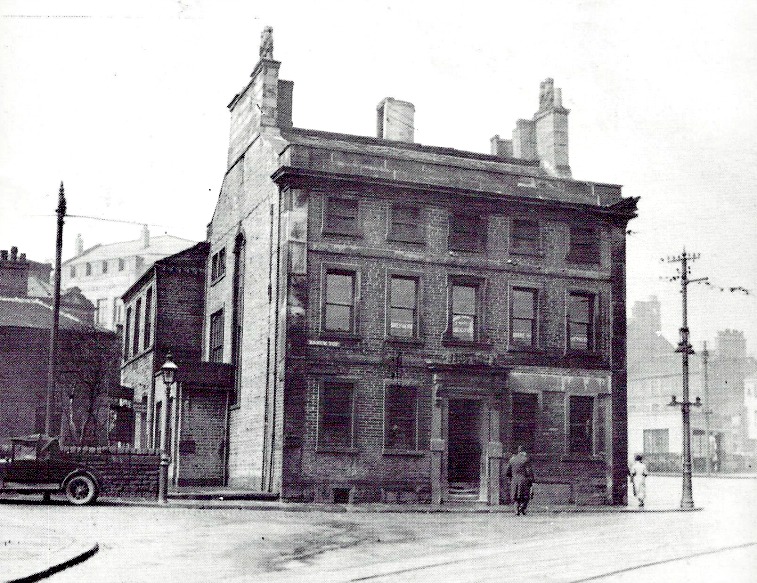
Barum House was where Tabitha Bagnold lived latterly, and died in 1855; and where her daughter Charlotte died six years later.
Tabitha’s daughter, Charlotte Akers - baptised Charlotte Bagnold at the Parish Church, 10th August 1798, had married Robert Akers (of Manchester, gent., who settled in Halifax thereafter) on 12th June 1821 - died at her home, Barum House, on 3rd October 1860, and was buried in St James’s Churchyard. Her son, William Bagnold Akers, joined the Halifax Post Office as a clerk about January 1839, and in July of the following year witnessed in the Magistrates Court against the thieving postman. He may have been the boy of fourteen, mentioned above. By 1845, William was Chief Clerk, and is then also listed as a Stock and Share broker. He worked at the Post Office until at least 1859. Certainly he did not succeed his mother as Post Master, and may have been for a while in poor health; he only survived her by six months, dying at Seedhill, Huddersfield in March 1861, aged 37, being buried in his mother’s grave at St James’s. Sadly their tombstones have long gone; their remains were transferred to Stoney Royd in July 1961.
The Post Office was moved further up George Street in 1863; this had a much larger floor area, and people could transact business under cover over mahogany counters. Then in 1887 a new purpose-built General Post Office was opened some fifty yards away in Commercial Street, in the building we have all known so well for so many years; but sadly, no longer available for its original purpose.
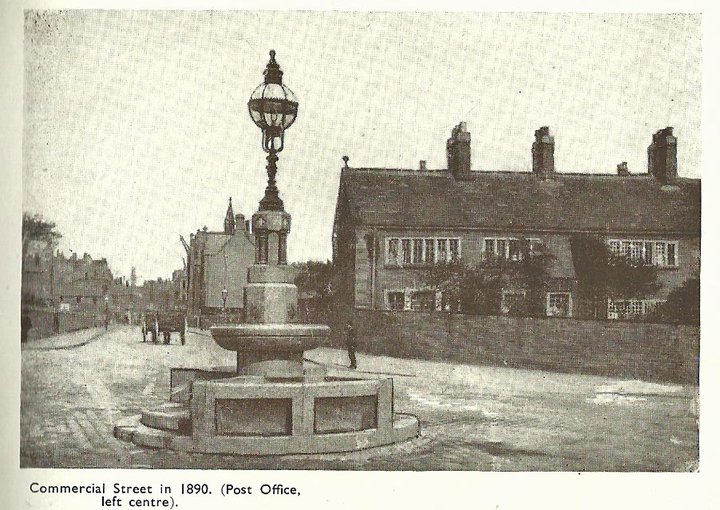
This
article was inspired by one entry in an old directory, and by one
gravestone in the Holdsworth Chapel at Halifax Minster; the latter
reads as follows:
In memory of Mary Wainman, who died Dec 28th, 1778, aged 70.
Also William Bagnold, her nephew, who died Octr. 17th 1810, aged 63.
Also Caroline Frances and Maria, his daughters, who died in childhood.
Also Harriet, daughter of the above Wm. Bagnold, who died Octr. 1st 1812, aged 24.
Also Ann, daughter of the above Wm. Bagnold, who died March 13th 1818 aged 14.
Also William, son of the above Wm. Bagnold, who died Octr. 17th 1818, aged 18.
Also John, son of the above Wm. Bagnold, who died Febr. 9th 1840, aged 30.
Also
Tabitha, wife of the above Wm. Bagnold, who died Decr. 28th
1855, aged 86 years.
As
a postscript, in examining various family relationships and
genealogies, I have discovered that Tabitha’s granddaughter
Caroline Akers, who married John Stores Smith at Halifax in 1850, had
an interesting grandson. He was to became Admiral Lord Fraser of
North Cape, the naval officer who was British signatory to the
Japanese instrument of surrender in Tokyo Bay in September 1945. Did
he send a postcard back to Halifax, I wonder?
David C Glover – June 2018
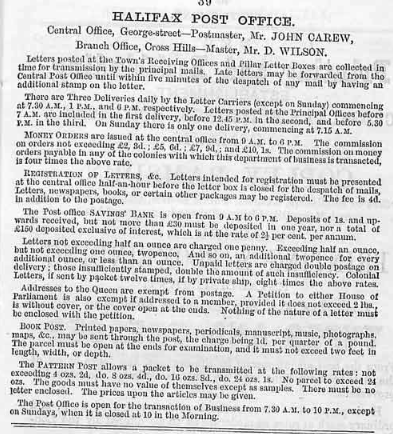
When Halifax had One Postman
And Letters took Three Days from London
(taken from Halifax Almanac 1937)
On June 23rd, 1937, the Halifax Post Office will have occupied the buildings in Commercial Street for 50 years. This is the longest period in which postal work in Halifax has been carried on in one building.
The late Mr. H. Ling Roth, former curator at Bank Field Museum, made an extensive search, both locally and at the GPO Record room at St. Martin-le-grand, London, for records of Halifax postal work. The results of his investigations were embodied in the eighth of his series of Bank Field Museum Notes, entitled "Halifax Posts." Extracts from these notes and also from records from the Halifax Post Office, have been used in compiling this history.
The earliest existing record at the GPO regarding the Halifax office is an account book of the year 1770, which relates to "Mary Wainman, deputy at Halifax; salary £60 3s. 4d." Letters, however, had been delivered in Halifax almost a century before that date. Post-marking letters by a stamp was introduced about 1660. A letter dated Feb 28, 1684, was sent from Jeremy Lister in London, to his brother, Samuel Lister, at Upper Brear, Halifax. The wrapper of the letter was presented to Bank Field by the late Mr. John Lister, M.A.
Difficulties of the Halifax postal service were discussed as early as 1759. Mr. Ling Roth discovered a letter written by a member of the Union Club to the editor of the "Union Journal," or "Halifax Advertiser," and published on June 19, 1759. The letter suggested a post road from Halifax, through Doncaster. The writer suggested that there would be easier conveyance of letters and the road would draw many London travellers and carriers to Halifax on their way to and from Scotland.
In 1759 there were three arrival posts per week- on Friday, Sunday and Tuesday. The post took 2 1/2hrs to three days to reach Halifax from London. Sometimes it did not arrive at all! In 1797 Halifax had under it as collecting stations: Heptonstall, Elland, Ripponden, Lightcliffe, Hightown and Dewsbury. Letters from London arrived the second day after dispatch at 7am, an improvement on the service in 1757. The return mail went at 3pm, so that all the collecting offices in the area had to send their letters to Halifax by horse post.
The old newspapers of the time tell of not infrequent encounters , between these horse-post men, who were always well armed, and highwaymen, and footpads. "though the Government post for the Halifax mails does not appear to have been attacked by highwaymen, the special post of the 'Halifax Journal' was attacked and robbed on Friday, Sept 11, 1801," says Mr. Ling Roth. "This enterprising journal had established a special express, employing a mounted messenger named Thomas Frubisher, to convey to Halifax from Ferrybridge, every Friday evening, the newspapers and letters which had arrived there by mail coach. On the night in question, Frubisher was attacked on Hartshead Moor, his pony as well as himself being brutally handled. A reward of £50 is said to have been offered for the apprehension of the ruffians, but nothing seems to have come of it."
The postal arrangements did not always give satisfaction, and on June 3, 1812, the Gentlemen, Merchants, Manufacturers and other inhabitants of the town and parish of Halifax sent a memorial to the Lords, the Postmasters-General, asking for an earlier arrival of the mails. They complained that owing to the late delivery an advantage was given to the merchants of Leeds, Wakefield, Rochdale and Manchester, not only in their own market in Halifax, but likewise at other markets. This complaint was discussed at a public meeting at Halifax in October, 1812, attended by the Post Office Surveyor. As a result, the Halifax service was accelerated and delivery of mails commenced at 7am in summer and 8am in winter.
In 1820, the scale of charges for letters was: Bradford 4d, Huddersfield 4d, Hull 8d, London 11d, Liverpool 8d, Leeds 5d, Manchester 6d and York 7d.
In 1790 the postmaster's name in Halifax was given as John Bagnold, and so far as can be ascertained, the posting office was in Winding Road. It would appear that when he died his widow, Tabitha Bagnold, carried on as postmistress, for she is shown in the accounts as holding the position in 1818 and again in 1823.
Illuminating reminiscences of the old Winding Road office are recorded in an unpublished manuscript, evidently some 70 years old, which was compiled as a description of Halifax in the last century. The writer, whose name is unknown, states that the Winding Road office was kept by Mrs. Bagnall for a great many years. It was the same building, he states, that is now the Bowling Green Inn, on the right-hand side of Winding Road, above Well Lane, proceeding towards Northgate
The only postman then for the township of Halifax - then the extent of the built-up portion of the town - was a man always called Joe Post. "He was a little thick-set man, who always wore a blue serge apron when delivering letters. He lived at the corner house at the top of Well Lane," states the writer.
"At that time, a letter from London cost 11d and from Manchester 7d. Consequently, when any person was travelling about the town or into another district, he was always asked by his friends to take them some letters to save the expense of postage. If a person's address was over the brook one penny extra was charged on each letter".
No records are available to show when the Winding Road office was given up, but in 1823, the Halifax Postal Office was at No.6 Westgate. This again was a small office attached to the residence of the postmistress. At this time, one man was still sufficient to deliver all the Halifax letters. His name was John Milner. He is believed to be the husband of a Mrs. Susannah Milner who kept a bookseller's shop in Cornmarket.
In 1837, the office was removed to 10, Cheapside and curiously enough, in Nov7th of that year, the "Halifax Guardian" contained the following advertisement: "Apartments to let where every accommodation will be given. Apply at the old Post Office in Winding Road."
Postal business was gradually growing in Halifax, and later, another postman was appointed, and in 1840, a third man. His appointment was the sign of the growing popularity, which was undoubtedly due to the establishment of the system of uniform penny postage within the UK in 1840. Closely following this came the money order system, though it had a previous existence as a private concern, and in 1848, the Book Post was established.
The growing postal work was also evidenced in the dissatisfaction at the arrangements and facilities provided at the Cheapside office. In the following note complaining of the want of letter-receiving offices in Halifax
When Halifax contained a fourth of the present population, one post office for the receipt of letters, even though situated near Smithy Stake, was deemed sufficient. Now, with a population of nearly 30,000 surely it is entitled to at least three receiving houses.
During the next few years there was a considerable amount of dissatisfaction expressed at the postal service, and even a local postal committee was formed to improve matters.
On August 22, 1846 the "Halifax Guardian," reporting on the arrangements relating to the arrival of the Halifax mail, said:
These new arrangements are highly detrimental to the public and bespeak a total contempt on the part of the Post Office authorities to the mercantile interests of this important district. With the exception of the alteration in the earlier arrival of the London mail, all the postal arrangements have been of a retrograde character. We trust these arrangements will not be suffered long to continue.
The same complaints were being made in the following years - 1847 to 1850 - and there were many references to "the antediluvian arrangements and miserable accommodation provided." On June 23, 1849, the "Halifax Guardian" suggested that a subscription list should be opened for the purpose of erecting more suitable premises.
On June 15, 1850 the "Guardian" said:
Perhaps in no town in the West Riding have the public been put to greater inconvenience arising from the want of suitable and adequate postal accommodation as Halifax. So far as accommodation for the public is concerned, there is none, and the wonder is how the clerks have managed to conduct so large an amount of business with so few blunders with the present contracted office - in Cheapside. Several attempts have been made by appeals to the Town Council and the Post Office authorities to remedy this serious inconvenience, but without success. An appeal to the merchants, manufacturers and the public, has, however met with a more favourable issue, and there is now every prospect of Halifax possessing a post office in every way proportionate to the wealth and importance of the district.
Premises have been taken at No.6 George Street, adjoining the Union Bank - formerly occupied by Messrs. Holdsworth and Co. In addition to providing increased accommodation for the clerks, a large waiting room eight yards by 13 yards will be provided for the public and the convenience of those who rent letter boxes. An estimate for the alterations is £300, towards which a sum of £270 has already been subscribed.
It was not until April 14, 1851, that the new premises at No.6 Geeorge Street,were opened. Apparently, the premises have been re-numbered since 1851, for the even numbers are now on the opposite side of the road to Somerset House, which was formerly the offices of the Halifax and Huddersfield Union Bank.
The public entrance was in George Street, and mails were brought in through the yard by the back of the Griffin Hotel. Mrs. Charlotte Akers was the postmistress and Esau Greenwood was the chief clerk. Commenting on the new premises the "Guardian" of April 12, 1851, stated:
These premises have been completed by a private subscription and might have been appropriated to their intended use two months ago, but for the obstacles thrown in the way of the committee by the Post Office authorities in London, whose movements have always been of an antediluvian character. It would appear as if their sole study consisted in putting the mercantile and other classes to the greatest possible inconvenience. The opening of the new Post Office arises from the public spirit of the inhabitants of Halifax, and not from any desire on the part of the Post Office authorities to give increased facility to the inhabitants.
We believe Halifax can now boast of one of the most commodious and convenient post offices in Yorkshire, and one which will be amply commensurate of the increasing business of the neighbourhood for many years to come. The situation is the most convenient that could have been selected, and the public will now have the advantage of protection from the weather while they wait for their letters. In addition the public will enjoy the benefit of a well-regulated illuminated clock, which has been placed in the doorway of the Post Office, and which we hope will become the standard for other clocks in the town.
In 1859, the staff had increased to four clerks, a stamper, and an outdoor force of eight postmen. About this period, some 22,000 letters per week were delivered - less than the daily total at the present time.
The Post Office Savings Bank was established in 1861 and the transfer of the telegraphs in 1870 added enormously to the work of the department. In Halifax during the first year of the transfer of the telegrams, the number forwarded and received was 48,356, in the second year it was 76,075, and in 1886 the number had risen to 245,953.
For some years the accommodation in the George Street office had been totally adequate, and on June 23, 1887, the present buildings in Commercial Street were opened for business. The building was erected from plans prepared by Mr. Hy Tanner, architect to the Board of Works of this district. The following is an extract from the "Halifax Courier":
The site covers 1,050 sq yards. In character, the structure is partly early English, and is quite worthy of the many excellent buildings which have been erected in this vicinity in recent years. The principal front is in Commercial Street, along which it extends 108 feet. The building rises into three gables, the central part projecting a few feet. thereby giving an agreeable and broken effect. The public office is 43 feet by 16 feet, so that the accommodation for the public will be largely increased as compared with the present office in George Street.
The telephone room was immediately above the public office. This room was a new departure, for there were no telephones at the old office. The contractors for the building were Messrs. Armitage and Hodgson of Leeds. Mr Hodgson was formerly of Halifax.
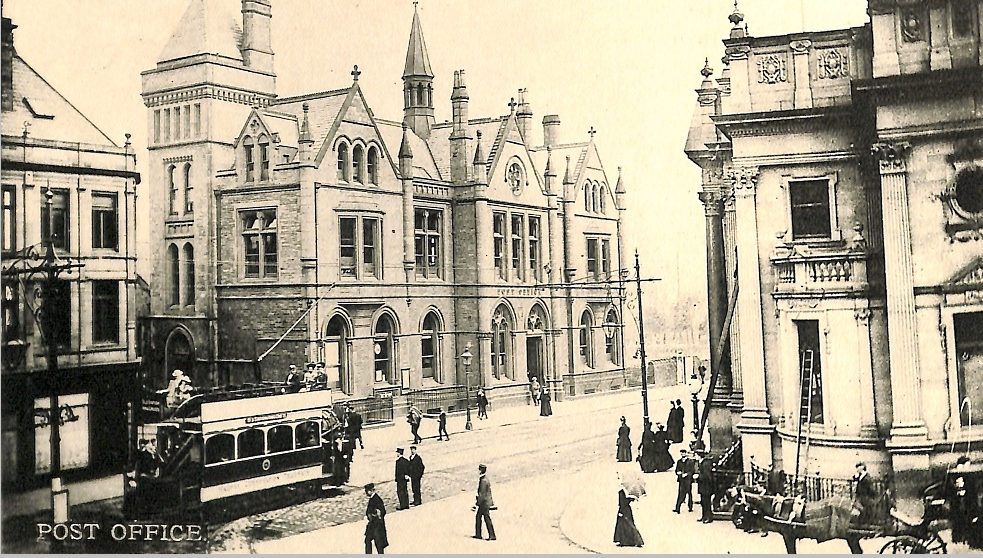
There was apparently no official ceremony when business was commenced in the new building. There was, however, a dinner given to the staff, the funds being provided by subscribers and friends, among whom Mr. J.H.Paskin and Mr. Bradley Brown took a prominent part. The dinner was held in a large room of the office. A report of the proceedings was given in the "Halifax Courier" of June 25, 1887. The chairman was Mr. L.J.Crossley, J.P. who said that all Halifax would be glad that they had at last got a sensible office. He remembered the old Post Office in Cheapside and the removal up to George Street. Dr. West Symes, Medical Officer to the Post Office was present.
Mr. E.Francis was Postmaster at the time, and in his address said that the building marked a great improvement. It was thought when they took over the old office that it would supply all their needs for a lifetime but its capacity had been insufficient for several years.
The first established Postmaster in the Government service in Halifax was John Carew, who served between 1863 and 1867.
The following is a list of the Postmasters who succeeded him:
Edward Francis, 1867 to 1893. He was 34 years of age when appointed to the Preston office.
Robert Douglas, 1894 - 1899,
J.W.P.Gregson, 1899 - 1905,
J.W.Tucket, 1905 - 1913,
W.Carmichael, 1913 - 1919,
T.J.Hubbard, 1919 - 1925,
J.E.Barlow, 1925 - 1931,
J.S.Reid, 1931 - 1934,
W.A.Tomkinson, 1934 -
By 1936, the whole Halifax postal area covered over 40 sq miles and included Hebden Bridge, Sowerby Bridge and Elland- 20 years ago they were separate areas. The staff by now was; Head-postmaster, one super intendant, two assistant super intendants, three postmasters, six overseers, 59 sorting clerks and telegraphists, two assistant supervisors, 41 telephonists, one inspector of postmen, two assistant inspectors, three head postmen and 194 postmen, ten telegram messengers, 75 sub-postmasters and a number of cleaners etc.
During the last 50 years there have been two important structural alterations to the building. These have both been to the rear of the premises. The first was in 1909-1910 when the sorting office was extended and the second when the extension in the Old Cock Yard was erected. This was commenced in 1924 and completed in 1927. It added to the building the present large sorting office on the ground floor, over which is the automatic exchange. The actual change-over was made in two minutes, but it meant the saving of countless hours to all subscribers.
To give some idea of the services performed by the Halifax Post Office, it may be mentioned that today, during an average week,
Nearly 1,000,000 letters are posted and delivered;
22,000 parcels are posted and delivered;
Postage stamps sold cost over £800;
Over 1,200 telegrams are sent and delivered;
30,000 telephone calls and inquiries are dealt with in the exchange;
Over 9,000 postal orders are sold and paid;
Over 2,500 pensions are paid; and
Over 35,000 wireless licences are issued annually.
The work still continues to expand and an increasing number of men and women are employed, despite such mechanical aids as automatic letter stampers, etc
Report from 1937 Halifax Almanac
Images of Halifax Post Office
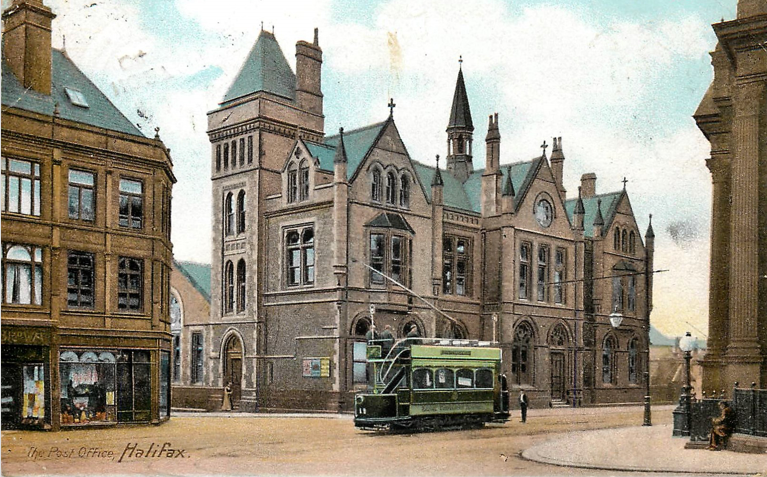
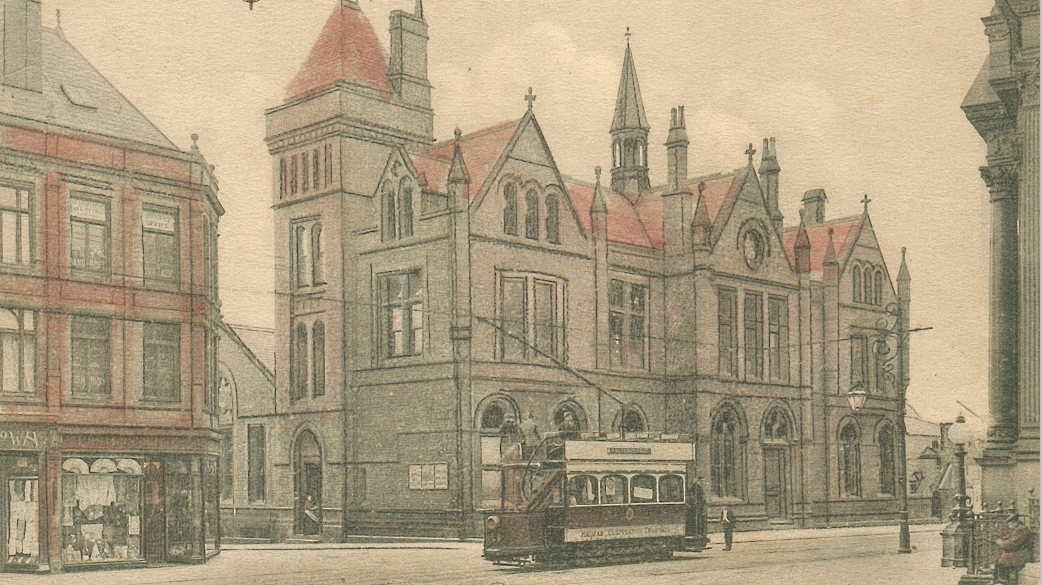
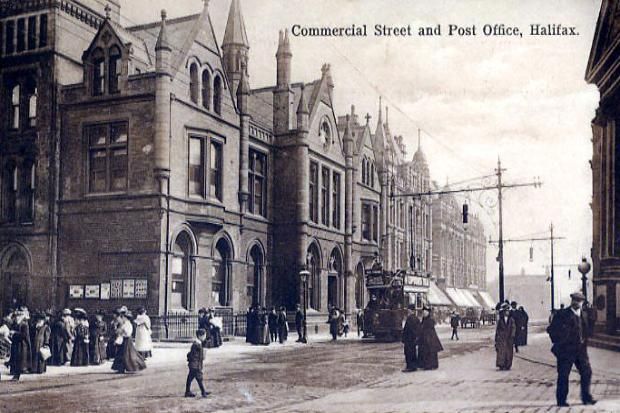

If you have enjoyed your visit to this website, please spread the word by clicking the 'like' and 'share' buttons below. Thank you
